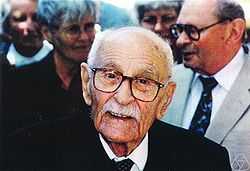Leopold Vietoris
| Leopold Vietoris | |
|---|---|
 Leopold Vietoris on his 110th birthday | |
| Born |
4 June 1891 Bad Radkersburg, Styria Austria-Hungary |
| Died |
9 April 2002 (aged 110 years, 309 days) Innsbruck, Tyrol Austria |
| Nationality | Austrian |
| Fields | Mathematics |
| Institutions | University of Innsbruck |
| Alma mater | University of Vienna |
| Doctoral advisor |
Gustav Ritter von Escherich Wilhelm Wirtinger |
| Doctoral students |
Eva Ambach Walter Dürk Helmut Grömer Kurt Hellmich Hiltrud Jochum Johann Leicht Fortunat Pescolderung Martha Petschacher Gerhard Riege |
| Known for |
Contributions to topology Being a supercentenarian |
| Spouse |
Klara Riccabona (m. 1928-1935) (her death) Maria Josefa Vincentia Vietoris, born von Riccabona zu Reichenfels (m. 1936–2002) (her death) |
Leopold Vietoris (/viːˈtɔərɪs/; German: [fiːˈtoːʀɪs]; 4 June 1891 – 9 April 2002) was an Austrian mathematician and a World War I veteran. He was born in Radkersburg and died in Innsbruck.
He was known for his contributions to topology—notably the Mayer-Vietoris sequence—and other fields of mathematics, his interest in mathematical history and for being a keen alpinist. Vietoris attended the University of Vienna, where he earned his Ph.D in 1920.[1]
Biography
He studied mathematics and geometry at the Technical University in Vienna.[1] Vietoris was drafted in 1914 in World War I and was wounded in September that same year.[1] On 4 November 1918, one week before the Armistice of Villa Giusti, he became an Italian prisoner of war.[1] In autumn 1928 he married his first wife Klara Riccabona, who later died while giving birth to their sixth daughter.[1] In 1936 he married Klara's sister, Maria Riccabona.[1]
With his wife Maria Josefa Vincentia, born von Riccabona zu Reichenfels (18 July 1901 – 24 March 2002), dying at age 100, they became one of the eldest couples of the world, having the seventh-highest aggregate age of a married couple (total combined age). Their combined age at the end of their marriage, 211 years and 177 days, is the second highest on record. Vietoris died two weeks after her death.
Vietoris was survived by his six daughters, 17 grandchildren, and 30 great-grandchildren.[2]
He lends his name to a few mathematical concepts:
- Vietoris topology (see topological space)
- Vietoris homology (see homology theory)
- Mayer–Vietoris sequence
- Vietoris–Begle mapping theorem
- Vietoris–Rips complex
Vietoris remained scientifically active in his later years, even writing one paper on trigonometric sums at the age of 103.[3]
Vietoris lived to be 110 years and 309 days old, and became the oldest verified Austrian man ever.
Decorations and awards
- This article incorporates information from the equivalent article on the German Wikipedia.
- Austrian Decoration for Science and Art (1973)
- Grand Gold Decoration for Services to the Republic of Austria (1981)
- Honorary member of the German Mathematical Society (1992)
See also
- List of Austrian supercentenarians
- List of the verified oldest men
- List of veterans of World War I who died in 2002
References
- Notes
- ↑ 1.0 1.1 1.2 1.3 1.4 1.5 Reitberger, Heinrich (November 2002). "Leopold Vietoris (1891-2002)". American Mathematical Society. Retrieved 2003-09-05.
- ↑ "Professor Dr. Leopold Vietoris". Geo Imagining. Retrieved 2009-10-11.
- ↑ Reitberger, Heinrich (November 2002). "Leopold Vietoris (1891–2002)" (PDF). Notices of the American Mathematical Society 49 (10): 1235. Retrieved 26 January 2014.
- Bibliography
- Beyond art: a third culture: a comparative study in cultures, art, and science in 20th century Austria and Hungary, Springer, 2005, p. 261.